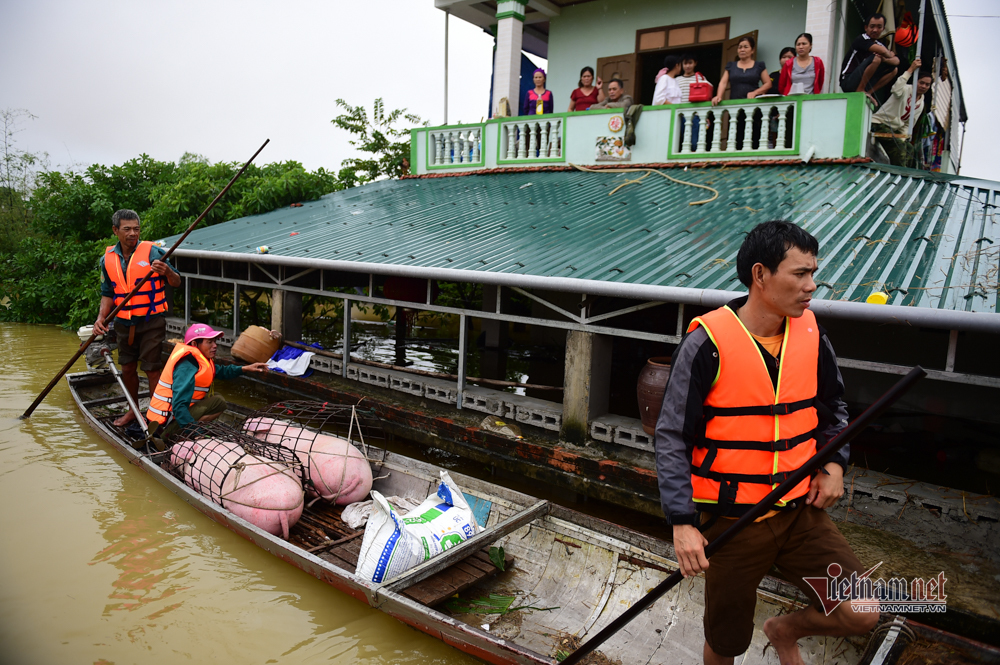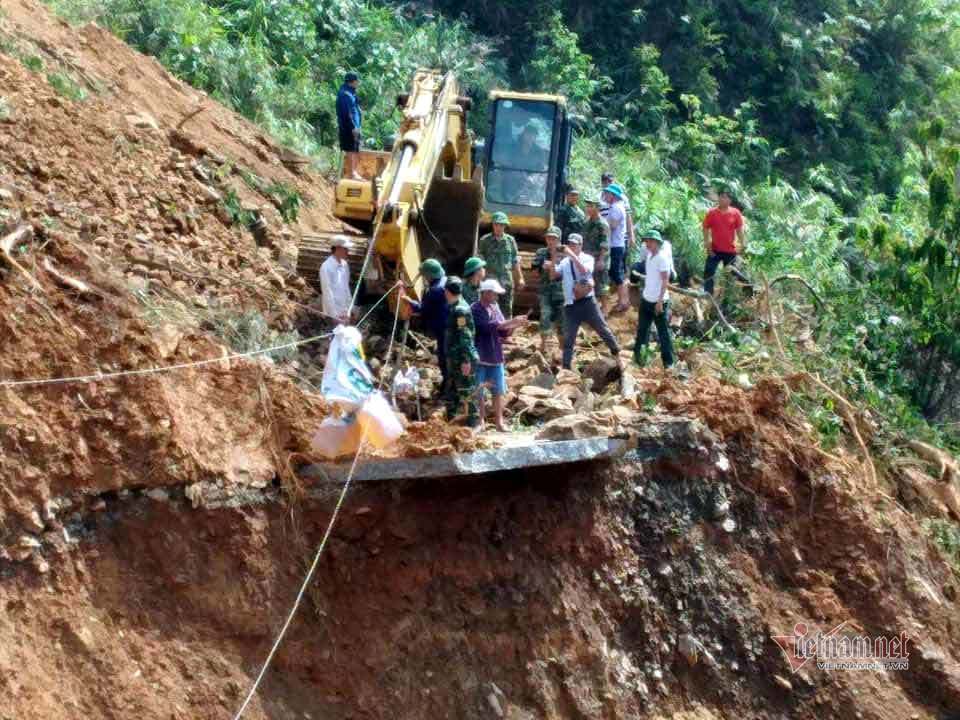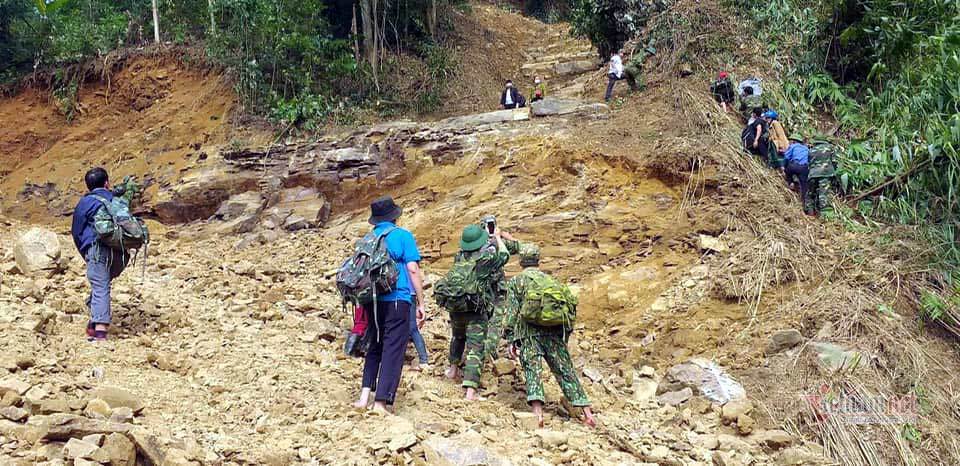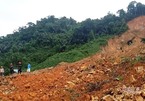Many people have died in the central region, thousands of people are living outdoors, and infrastructure has been destroyed by floods and landslides. Why does the central region suffer from disasters every year?
Objective reasons
 |
|
Prolonged heavy rains cause water levels in Quang Binh’s rivers to rise, inundating more than 71,000 houses. Photo: Thanh Tung
|
In the central region, with its typical characteristics of heavy rains and floods, the river bed is steep and narrow, and the river mouth is alluvial and changes each year. There are many weak geological areas... The area often suffers great losses during the annual flood season.
The total cumulative rainfall from October 15 to October 19 was very high. In the provinces from Thanh Hoa to Nghe An, rainfall was from 260-220 mm. It was 450-840 mm in the provinces from Ha Tinh to Thua Thien – Hue, and 80-115 mm in the southern part of the central region (190-320 mm in the provinces from Da Nang to Quang Ngai).
Subjective reasons
Scientists have warned that humans will have to pay high costs for the destruction of nature. The lack of a plan for sustainable socio-economic development, which causes chaos in building infrastructure, has made the task of preventing natural disasters more difficult.
 |
|
A seriously eroded road in Huong Hoa district, Quang Tri province on October 23. Photo: Phan Vinh
|
Weather forecasts and warnings have not kept up with unusual weather developments. The construction of roads that are perpendicular to the flow, with insufficient apertures for drainage, causes great fluctuation in the water levels between regions. Unreasonable hydropower development and infrastructure construction, and deforestation also contribute significantly to natural disasters.
In hydropower planning studies, the task of flood reduction and supplying additional water to the downstream during the dry season has been considered. In fact, some hydropower reservoirs have partly performed this task, such as Trung Son reservoir on the Ma river (150 million m3), Hua Na reservoir on the Chu river (100 million m3), Ban Ve reservoir on the Ca river in Nghe An province (300 million m3), Quang Tri reservoir on the Rao Quán river (30 million m3), and Binh Dien reservoir on the Huu Trach river (70 million m3).
For small and medium hydropower projects, as they are mainly located on tributary of branch rivers or streams with small catchment areas and large slopes, the reservoir capacity is very small, so the flood reduction effect is negligible.
The construction of hydropower projects requires conversion of the use of certain areas of forested land. For these projects, the investor must fulfill the obligation of planting forests to compensate for the forest land moved for hydropower projects, according to a circular issued in 2019 by the Ministry of Agriculture and Rural Development.
According to the General Department of Forestry under the Ministry of Agriculture and Rural Development, by September 2019, 30,305 hectares of forest of this kind had been planted. However, planted forests are not as effective in protecting the environment as natural forests.
Solutions
Agencies from the central to local levels need to review and incorporate the task of natural disaster prevention into the general planning of the sectors and the overall plan, and improve the quality of weather forecasting and warnings, as well as proactively relocate people to safe areas before natural disasters occur.
Reviewing construction standards to respond to disasters is another solution. The infrastructure, especially roads, must have enough apertures for flood drainage. Currently, in addition to the single-lake operation with full operating requirements in the flooding and dry seasons, local governments should ask small and medium hydropower reservoirs in the same basin to coordinate operations to enhance safety in the flood season, in line with demand for water exploitation and use in the dry season for the downstream.
Implementing the National Assembly’s resolution 62 in 2014 on strengthening the management of planning, investment in construction, and operation of hydropower projects, and the Government’s resolution on an Action Plan in response to resolution 62, the Ministry of Industry and Trade issued a plan that removed 8 ladder hydropower projects, 472 small hydropower projects and 213 potential locations for hydroelectricity from hydropower development planning. These are projects that occupy a lot of land, have great impact on the environment and society, or have low economic efficiency.
The ministry is not considering supplementing the planning of small-scale hydropower projects or any hydropower projects that occupy natural forest land.
 |
|
Heavy rains cause floods and landslides on hilly lands. Photo: Phan Vinh
|
The flood drainage capacity of the central coastal residential areas should be enhanced and the flood resistance of river dike systems must be improved.
Other solutions include: prevent floods to protect people in river basins, ensuring production of summer-autumn and winter-spring crops, with a flood frequency of 5-10% (equivalent to floods occurring every 10-20 years); consolidate dikes of the Ma, Chu, Ca and La rivers to withstand floods after 2020; strengthen other river dikes from Ha Tinh to Thua Thien - Hue provinces to combat summer-autumn and late floods, actively prevent and adapt to main-season floods; prevent early floods and drain late floods to ensure production of the winter-spring and summer-autumn crops, with a rate of 5-10% for the south central region; and study and implement solutions to stabilize the river bed, regulate rivers, and combat sedimentation at estuaries of Thu Bon, Ba, Lai Giang, Tra Khuc, Tra Cau, Ban Thach and Cai Nha Trang rivers;
Also, consolidate and improve flood resistance capability in major river basins in the North Central region with a flood control level after 2020 of <1% for Huong and Ca rivers and <7% for Huong river; proactively prevent, avoid and adapt to floods to protect people in river basins of the South Central Coast, the Central Highlands, and the Southeast, ensuring production in the Summer-Autumn and Winter-Spring crops, with flood frequency of 5% to 10%.
For the South Central region, effectively regulate reservoirs to supply water to the downstream area; rationally operate the reservoir system in the river basin to ensure safety for downstream, serving daily life, production and natural disaster prevention; prevent, avoid and adapt to main-season floods; prevent early and late floods in service of winter-spring and summer-autumn crop production; increase the drainage capacity of drainage axes, to study solutions to overcome and fill up river and sea estuaries to drain floods.
Also, make 1:25000 maps to classify risks of floods, earthquakes, landslides and forest fires in key areas.
Depending on the level of the forecasted risk, district-level authorities need to establish a stockpile of essentials, at least instant noodles and drinking water, alum to settle the cloudy water, and water disinfecting tablets so that people in disaster affected areas can treat available water sources.
When there is no military conflict, the army does rescue tasks very well, so the army should have a professional rescue force, which will coordinate with the rescue force of the civilian side to save people when natural disasters occur. The destructive power of nature can be terrible, while human power is very small, so we are only able to minimize, proactively prevent natural disasters, not combat natural disasters, especially in the central region.
It is necessary to establish response instructions and organize propaganda for relevant units and companies. Each related hydropower, irrigation project, and construction project in the mountainous and forest region... needs to have an incident response process.
In order to proactively prevent natural disasters effectively, the government and relevant agencies need to develop a unified action plan based on a common vision: “Effective disaster management, wise use of resources, respond to climate change and sea level rise flexibly, for a stable and prosperous economy, diverse and sustainable environment."
|
Vietnam cancels 400 small hydropower projects The National Assembly has disapproved more than 400 small hydropower projects which fail to meet regulations on preventing flood and water, according to Minister of Natural Resources and Environment (MoNRE) Tran Hong Ha. Minister Ha told local media on October 24 that the large-scale hydropower plants are well complying with the flood prevention and water regulations for the dry season. Therefore, the MoNRE is not encouraging the development at all costs of small hydropower projects. The minister stressed that the historic flood in the central region has been caused by climate change. This is a combination of several natural disasters at the same time with the scale unseen for decades. The ministry has considered that development of small hydropower plants should not be continued. Wherever a small hydropower plant is necessary, its construction should take into consideration environmental issues, life of aquatic animals and sediment maintenance to ensure harmony with the environment. He hoped that the management tools for environmental impact assessment and environment regulations will gradually restore the environment. “Human beings must live in harmony with and respect nature", he said. The draft revised Law on Environmental Protection has also identified projects dumping large amount of waste and causing severe impact on the environment for centralized management. It also removed unnecessary administrative procedures for environmentally-friendly projects that will contribute to socio-economic development. The draft law was submitted to the National Assembly in mid-2020 and is expected to be approved on November 11. Hanoitimes |
To Van Truong

Will hydro-power plants cause more floods in Vietnam?
If there were no hydroelectric dams, floods would still occur, even at a higher level. In many cases, without hydropower reservoirs, floods would be more serious.